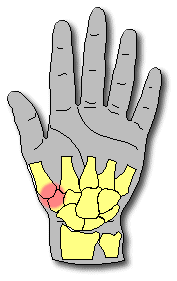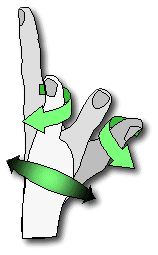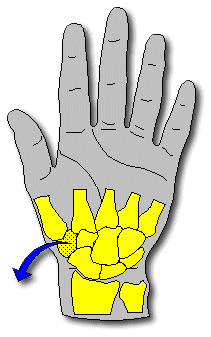| What
is it? |
| The joint at the base of the thumb which
allows for the swivel and pivoting motions of the thumb is referred to
as the basal joint or thumb CMC (carpometacarpal) joint. Because of its
design, it tends to wear out and develop arthritis early in life. Basal
joint arthritis is also common in people who have osteoarthritis. |
  |
|
| What
caused it? |
-
This joint appears to be particularly prone
to wear and tear from normal use of the hand. Many people appear to be
predisposed to arthritis in this joint, with or without arthritis in their
other joints.
|
| What
can you do to help? |
-
Ice for five to fifteen minutes at a time
on the area which is most swollen and tender.
-
"Over the counter" non-steroidal anti inflammatory
medication (NSAID), such as aspirin, ibuprofen, naprosyn, or ketoprofen.
Check with your pharmacist regarding possible side effects and drug interactions.
-
A splint or brace which supports both the
wrist and the thumb. A wrist support splint which doesn't support the thumb
is not as effective as one that does.
-
Wait and watch.
|
| What
can a therapist do to help? |
-
Provide a variety of hand splints to support
the thumb and the wrist.
-
Help identify aggravating activities and suggest
alternative postures.
-
Massage, heat, ice and other treatments aimed
at making the area more comfortable.
|
| What
can a doctor do to help? |
-
Confirm that this actually is the problem.
-
Prescribe stronger NSAID medication or cortisone
type medication.
-
Prescribe hand therapy and/or a custom prescription
splint.
-
Give a cortisone shot into the joint.
-
Perform surgery to reconstruct the joint.
 |
There are many different operations that
may be done for this condition, but a common approach is perform a total
joint reconstruction, which involves three main steps.
First, the trapezium bone at the base of
the thumb is removed. This bone has joint connections to three other bones
- and any of these may develop arthritis. |
 |
The second step in the surgery involves
making a connection between the adjacent sides of the base of the thumb
and index finger - to maintain the thumb position. This connection is usually
made with a tendon graft and can be done in several different ways.
The third step is to make a cushion to
pad the space between the bones where the trapezium bone used to be. This
cushion is usually also made from a tendon graft so that the base of the
thumb rests on a pillow of your own body tissue, rather than on the rough
surface of an arthritic bone.
Some surgeons then hold the bones in place
with a temporary steel pin. |
Recovery takes about three months. Therapy
recommendations vary, but a rough guide is - splint continuously
except for bathing 4 to 6 weeks, then progressive mobilization and strengthening
exercises for another 4 to 6 weeks to recover of strength and dexterity.
Most, but not all patients do this second phase supervised in therapy.
Anticipate no two handed sports or heavy two handed lifting for 10 - 12
weeks after surgery. Most strength recovery occurs in the first few months,
but can continue to improve for a year or more. |
| How
successful is treatment? |
-
Many people with mild symptoms will improve
with a limited period of anti-inflammatory medication and avoiding painful
activities.
-
A cortisone shot into the sore area helps
most people - at least temporarily. When temporary, relief usually lasts
about two months. One or two shots provide permanent relief for less than
half of people with this problem.
-
Surgery helps over four out of five people
with this problem, but as many as one out of five will have a new problem
after surgery, such as numbness on the back of the hand or tenderness of
the scar. Surgery is generally helpful in relieving pain, but two problems
are not usually improved following surgery:
-
When the problem has caused the thumb to draw
into the palm (thumb adduction contracture), surgery does not usually bring
it back out, especially if the next joint further out on the thumb has
stretched out and bent backward (thumb carpometacarpal hyperextension deformity)
-
Pinch strength may not improve adequately,
although pain associated with pinch usually does.
-
The appearance of the base of the thumb may
change with surgery.
|
| What
happens if you have no treatment? |
-
It depends on how much it is bothering you
- it really is a quality of life issue. This is not a problem which can
spread to other parts of your body. Many people have thumb pain which subsides
after a few years, when the arthritis and irritation in this joint "burns
out".
-
However, there probably is a limited period
of time during which surgery can give the best result. After a period of
years, the thumb weakness and the loss of motion of the thumb may not be
reversible even with surgery.
-
The main reason to do surgery is to relieve
pain and, when possible, prevent the progressive weakness and deformity
which may occur. Some people will have a mild problem which flares up from
time to time, and treat it themselves or ignore it, others will have a
severe problem which prevents them from doing many things with their hand,
and feel that they have no choice but to have surgery.
|
|